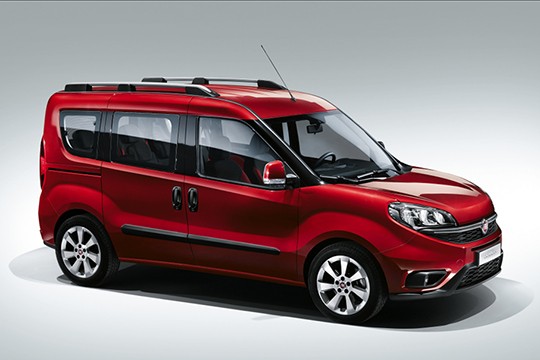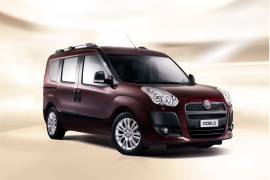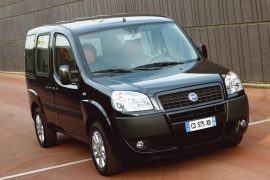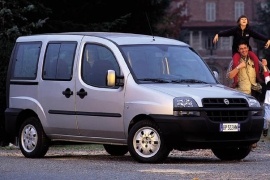FIAT Doblo Models/Series Timeline, Specifications & Photos
First production year: 2001
Engines: Gasoline, Natural gas, Diesel
Body style: Van
The facelifted version of the Fiat Doblo was introduced in 2015 at the Geneva Motor Show. Despite being a utility van, it was factory built as an MPV as well.
In 2000, Fiat decided to build a utility vehicle that could cover most of the urban needs for a small shop. It was a huge success and, in 2010, it introduced the second generation. It was offered in a few sizes, to fit everyone's needs and pockets.
The 2015 Doblo MPV was more about sense than styling. It was a very practical vehicle, easy to drive, with great visibility and a huge luggage area. But the styling was not completely removed from the equation. Its new, swept-back headlights, the ascending beltline for the windows, and the tall greenhouse were specific for its class. The flared wheel-arches created a sportier look, even though it was not quite a sporty vehicle. In the back, the Doblo was available with either a liftgate or two half-doors.
Inside, the Doblo MPV featured a dashboard that resembled most of the van's version, but with new additions. The steering wheel was different and an infotainment system with a 5” touch-screen was installed. Depending on the version, the car was available with up to seven seats. The last two were placed in the trunk area and could have been removed and left in the garage to increase the trunk space.
For the drivetrain, the Doblo MPV was fitted with a choice of gasoline and diesel engines. On specific markets it was available with CNG (Compressed Natural Gas) as well. The manual gearbox was the only option for most of the versions. Only the 1.6-liter 90 hp was available with a 5-speed automatic.
Fiat introduced the second generation of the Doblo in 2010, which was built in Turkey and featured unusual technical solutions for its segment.
The Italian automaker understood that the MPV segment was dead in Europe. However, families still needed vehicles with roomy interiors to move around. Thus, they thought about building a light commercial vehicle and then adapting it. That was smart and allowed the Italian automaker to offer the car at a lower price since most of the development costs were split with the commercial-vehicle department. Last but not least, some of its underpinnings were already implemented in other Fiat vehicles.
Based on an adapted platform shared with its smaller siblings Qubo and Grande Punto, the Doblo kept the same two-box volume architecture with a short hood, a steep windshield, and a greenhouse followed by a vertical drop at the back, where the automaker provided the vehicle with ether side-hinged doors or a tailgate. On the sides, the sliding rear doors helped the ingress and egress to the car, while the generous window area gave the passengers a clear view of the surroundings.
Inside, the tall front seats were designed mainly for an LCV user who has to spend many hours behind the wheel. As a result, the driving position was comfortable. Moreover, the gear stick was placed upper on the center console, one palm away from the steering wheel. Finally, the dials inside the instrument cluster were fronting the driver, providing all the necessary information for the one behind the wheel.
Underneath the hood, Fiat installed a 1.4-liter gasoline engine as the base version, while the 1.3-, 1.6-, and 2.0-liter versions were turbo-diesel. Unusually, the Doblo sported an independent rear suspension, which was unique in its segment. That solution helped the vehicle provide more comfort for the rear passengers.
Starting with 2005, all vehicles sold in the EU had to comply with the Euro 4 pollution norms, and Fiat chose that year to introduce the facelift for the Doblo range.
Even if it was designed as a light utility vehicle, the Doblo was a very good and competitive MPV on the market. One of the most important differences between the Italian vehicle and its competitors was the independent rear suspension, which ensured a higher comfort level over bumpy roads.
After the big fail with the Fiat Multipla design, the Italian carmaker decided to introduce the Doblo in that segment. The car was available in two length versions and offered room for up to seven passengers. Its look was closer to a utility vehicle than to a minivan, but its functions were the same. The facelifted model featured numerous modifications on the front fascia, where there were bigger headlights and a new grille with the blue Fiat badge in the middle. The designers installed a ventilation area for the engine and two side-pods for the fog-lights on the lower bumper. In the back, the corner-mounted taillights were bigger and offered better visibility from behind.
The interior was enhanced with the introduction of a new infotainment unit, offered as an option, on top of the center stack. Fiat kept the transmission mounted upper, on the dashboard, instead of the floor-mounted one. Despite the new, enhanced design of the panels, the materials used had a similar quality as on the non-facelifted version.
Under the hood, Fiat installed only Euro4 engines. There was a choice of five engine versions, and the new 1.3-liter diesel proved to be one of the most fuel-efficient from its class.
Fiat stepped up its presence in the MPV segment with the introduction of the Doblo lineup in 2001, which it offered as a utility vehicle or as a family hauler that could do both jobs.
The Italian automaker was still working on the Doblo in 1997 when Renault stormed the market with the Kangoo, but it didn’t rush things. It tried to create a proper answer for that, and that came in 2000 at the Paris Motor Show as a 2001 model year. The range of products based on this platform was huge. With two wheelbases, four lengths, three heights, and seven engine versions, customers had plenty of options to choose from. In addition, the carmaker offered the passenger version in a few trim levels, depending on the market, and even an option for a sat-nav system.
Fiat penned the Doblo with a flat front fascia dominated by a black, egg-crate styled grille and bumper, which were left unpainted to lower repair costs in case of scratching. A horizontal plastic slat separated the headlights from the parking lights and blinkers mounted underneath them. The automaker created a flat, almost horizontal hood to improve the driver’s forward visibility.
From its profile, even the least tall version of the Doblo had an adult-sized height of 1,82 m (6.2 ft). The panoramic windscreen was slightly tilted rearward, while the side windows were flat and straight up, leading to a wider interior room. Depending on the trim level, the door mirrors sported body-colored caps but black mounting stalks. Fiat installed regular, front-hinged doors for the front occupants, while those for the rear passengers were of sliding type. Behind them, the automaker added a third row of windows with a pop-out opening system that improved in-cabin ventilation. Finally, at the back, Fiat offered the car with either a flat vertical tailgate or with a twin-door system.
Inside, the connection with a utility vehicle was noticeable, especially on the dashboard’s design, which sported the gear selector on the center stack, close to the steering wheel. It was a form-follow-function concept, which was not specific to Fiat. In front of the driver, the automaker placed a compact instrument cluster filled with two large dials for the speedometer and tachometer and two gauges for the fuel level and coolant temperature. In addition, a small LCD displayed the odometer. Atop the center stack, the automaker offered a few options for a stereo cassette player or even a navigation system with a five-inch touchscreen and a CD player. In the back, passengers sat on a bench seat that could be removed to enlarge the cargo area. A split-folding (60-40) bench seat was also available.
Under the hood, the Doblo started its journey with a choice of three engines: a 1.2-liter gasoline unit or a choice of two 1.9-liter diesel powerplants. Later, other options became available, but all of them sent the power to the front wheels via manual transmissions. At the front, the car featured McPherson struts, while the rear rigid axle was fitted with leaf springs.



